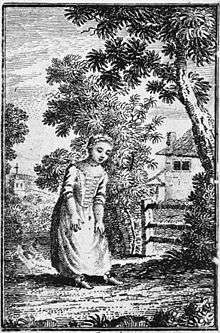The History of Little Goody Two-Shoes
.jpg)
The History of Little Goody Two-Shoes is a children's story published by John Newbery in London in 1765. The story popularized the phrase "goody two-shoes", often used to describe an excessively virtuous person, a do-gooder.[1]
Plot
Goody Two-Shoes is a variation of the Cinderella story. The fable tells of Goody Two-Shoes, the nickname of a poor orphan girl named Margery Meanwell, who goes through life with only one shoe. When a rich gentleman gives her a complete pair, she is so happy that she tells everyone she has "two shoes". Later, Margery becomes a teacher and marries a rich widower. This earning of wealth serves as proof that her virtuousness has been rewarded, a popular theme in children's literature of the era.
Publication

The anonymous story was published in London by the John Newbery company, a publisher of popular children's literature.[2] In his introduction to an 1881 edition of the book,[3] Charles Welsh wrote:
Goody Two-Shoes was published in April 1765, and few nursery books have had a wider circulation, or have retained their position so long. The number of editions that have been published, both in England and America, is legion, and it has appeared in mutilated versions, under the auspices of numerous publishing houses in London and the provinces, although of late years there have been no new issues.
The anonymous author
The story was later attributed to the Irish author Oliver Goldsmith, though this is disputed. Because Goldsmith frequently wrote for pay, and because of his copious fiction in essays (e.g., The Bee and Citizen of the World), the attribution to Goldsmith is plausible. Washington Irving was one supporter of Goldsmith's authoring the book; he said: "Several quaint little tales introduced in Goldsmith's Essays show that he had a turn for this species of mock history; and the advertisement and title-page bear the stamp of his sly and playful humor."[4] However, the book has also been attributed to Newbery himself and to Giles Jones, a friend of Newbery's.[5] "Booksellers" (publishers) such as Newbery would frequently pay authors for anonymous work, and no certain evidence of attribution has emerged.
Origin of the phrase "goody two-shoes"
Although The History of Little Goody Two-Shoes is credited with popularizing the term "goody two-shoes", the actual origin of the phrase is unknown. For example, it appears a century earlier in Charles Cotton's Voyage to Ireland in Burlesque (1670):[6]
Mistress mayoress complained that the pottage was cold;
'And all long of your fiddle-faddle,' quoth she.
'Why, then, Goody Two-shoes, what if it be?
Hold you, if you can, your tittle-tattle,' quoth he.
The name is used herein to point out the mayoress' comparative privilege; "Goody" (a corruption of "Goodwife"),[7] being the equivalent of "Mrs." and "Two-shoes", implicitly comparing her to people who have no shoes.
References
- ↑ Feinsilber, Mike and Elizabeth Webber (1999). Merriam-Webster's Dictionary of Allusions. Springfield, Mass.: Merriam-Webster. p. 234.
- ↑ Matthew O Grenby (2013). "Little Goody Two-Shoes and Other Stories: Originally Published by John Newbery". p. vii. Palgrave Macmillan
- ↑ Anonymous & Charles Welsh (Introduction) (1881). Goody Two-Shoes: A Facsimile Reproduction of the Edition of 1766 [EBook #13675] ((released as ebook October 8, 2004) 1881 Reprint of the 1766 ed.). London: Griffith & Farran (Successors to Newbery & Harris).
- ↑ Irving, Washington. Life of Oliver Goldsmith. ISBN 1-58963-236-2.
- ↑ Thwaite, Mary F. (1972). From Primer to Pleasure in Reading (2d ed.). London: Library Association. p. 50.
- ↑ "Goody Two-Shoes". American Notes and Queries. 5 (1): 3. May 3, 1890.
- ↑ Farmer, John Stephen; Henley, W.E. (1893). Slang and Its Analogues Past and Present: A Dictionary ... with Synonyms in English, French ... Etc. Compiled by J.S. Farmer [and W.E. Henley], Volume 3 (ebook digitized 2 April 2009 ed.). Princeton University: Harrison & Sons. p. 180. Retrieved 12 September 2015.
External links
| Wikimedia Commons has media related to Goody Two-Shoes. |
| Wikisource has original text related to this article: |
- Text of an 1881 reprint of the original version on Project Gutenberg
- Image of an 1787 Edition
- 18th Century Children's Book Collections at the British Museum
- 1888 chromolithographed pictorial edition at the Internet Archive